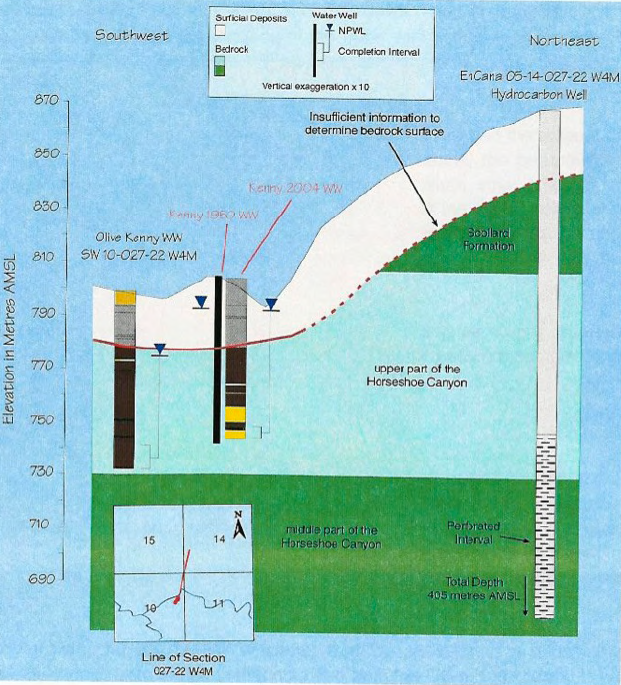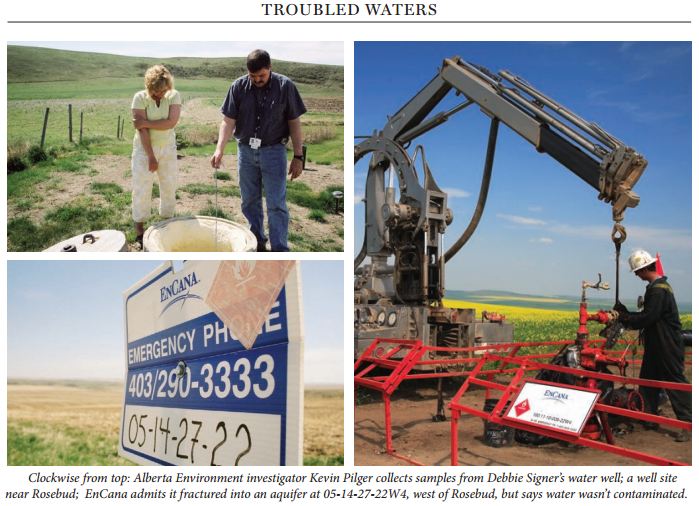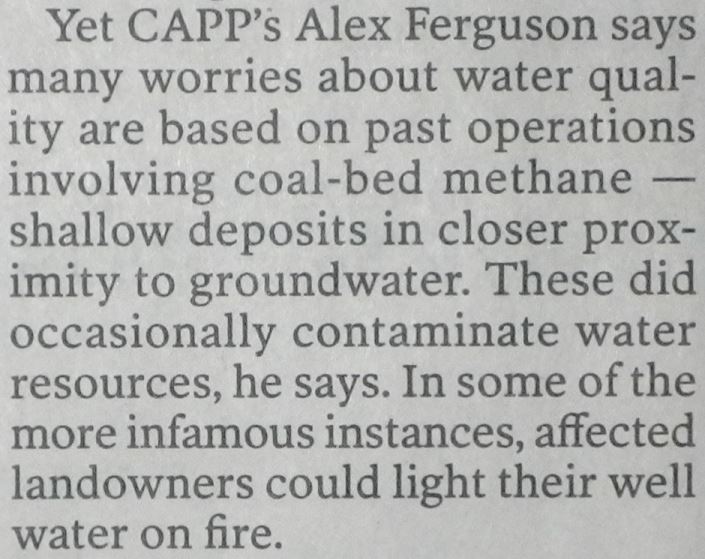Careful procedures followed in fracking by Michael Bell of Victoria, February 13, 2015, Times Colonist
Re: “Fracking raises concerns for environment, health,” letter, Feb. 11.
It is maddening when well-intentioned people, ignorant of geology and well-drilling, rant about fracking.
Before a well can be fracked, the hole has to be cased and the annulus cemented, usually from the bottom of the hole to the blowout preventers on the surface. Packers (plugs) are then run into the hole immediately below and above the strata to be fracked, so that only oil or gas formations are opened up, not aquifers. The oil industry, like any other, is intrinsically efficient and does not waste time, energy or money fracking freshwater formations. Besides, that is considered bad practice. [Emphasis added]
[Reality check for Mr. Bell:

Above Encana data on Alberta Groundwater Centre database, before Encana fractured Rosebud’s drinking water aquifers.

2004: EnCana’s intentional perfs into Rosebud fresh water aquifers, Source: Alberta Groundwater Centre (joint data base with Alberta Environment).
 “Bad Practice?” The upper and middle parts of the Horse Canyon are fresh water aquifers relied on by farms, businesses and families in the Rosebud community. In March 2004, EnCana fractured and injected 18 million litres of frac fluid under high pressure directly into Rosebud’s drinking water aquifers, in secret. Encana has frac’d hundreds of gas wells where the freshwater formations are in Alberta and continues to do so in “bad practice” regardless of how many drinking water supplies are contaminated.
“Bad Practice?” The upper and middle parts of the Horse Canyon are fresh water aquifers relied on by farms, businesses and families in the Rosebud community. In March 2004, EnCana fractured and injected 18 million litres of frac fluid under high pressure directly into Rosebud’s drinking water aquifers, in secret. Encana has frac’d hundreds of gas wells where the freshwater formations are in Alberta and continues to do so in “bad practice” regardless of how many drinking water supplies are contaminated.
Diagram above from: EnCana Corporation Site Investigation Report by Hydrogeological Consultants Ltd., January 2005.

“Encana admits it fractured into an aquifer at 05-14-27-22W4”
Photos and quote from Trouble in the Fields: Is our water safe? Alberta Views Oct 2006.
FOIP documents Ernst obtained in 2008 to 2012 from the Alberta Research Council (name changed to Alberta Innovates) show that Encana injected 18 million litres of frac fluid into Rosebud’s drinking water aquifers. In total, more than 70 million litres of frac fluid were injected into Encana’s 5-14 gas well under high pressure.
When water wells began to go bad, the regulators, Alberta government, Alberta Health, Wheatland County and the Alberta Research Council (now Alberta Innovates Technology Futures) helped cover up the law violations and frac harms. As of February 15, 2015, the chemicals Encana injected into drinking water zones at Rosebud remain secret.
2014 08 28: CAPP Confesses! To the Calgary Herald no less: Fracking did contaminate drinking water
Yet CAPP’s Alex Ferguson says many worries about water quality are based on past operations involving coal-bed methane — shallow deposits in closer proximity to groundwater. These did occasionally contaminate water resources, he says. In some of the more infamous instances, affected landowners could light their well water on fire.
[The “past operations” continue today. Encana is still getting approvals from the Alberta Energy Regulator to hydraulically fracture energy wells where the fresh drinking water is]
34. Further, and in the alternative, if the Plaintiff did incur any loss or damages as
alleged in the statement of claim, or at all, which the Province does not admit but rather
denies, then any such loss or damages were caused solely or substantially contributed to by the negligence of EnCana, for which the Province is not liable.
[Refer also to:
2014 08: Federally commissioned report, California Council on Science and Technology: Fracking is at shallower depths than previously realized, “It turns out that they’re fracking right around the water table” ]
…
Fracking raises concerns for environment, health by Lynn Borrows, February 11, 2015, Times Colonist
Recently, I attended a town-hall meeting in Nanaimo regarding liquefied natural gas and the process of its extraction called fracking. Vancouver-based documentary filmmaker Damien Gillis, in addition to scientist Eoin Finn, presented excellent research and visuals on this subject with local B.C. and national information.
The truth about fracking is disturbing. The process of fracking is destroying our clean water supply, our water tables, our long-term health, our environment and wildlife. Why are we not being told the entire picture by Premier Christy Clark and her government? Why does she just talk about job creation and dollars made on a short-term basis without mention of the serious and long-term negative effects of fracking?
Instead of creating relatively few jobs leading to serious public-health and safety issues for entire communities and our west coast, why not put more of our tax dollars and attention to the creation of alternative energy? Several countries, such as the Germany, Spain, Brazil and Denmark, are doing very well with their efforts in providing alternative energy.
May wisdom and common sense prevail in B.C. and Canada. [Emphasis added]
…
Effects of fracking should be examined by Richard MacKenzie, February 15, 2014, Times Colonist
Re: “Careful procedures followed in fracking,” letter, Feb. 13.
“The best laid schemes o’ mice an’ men gang aft agley.”
Fact: Studies have linked fracking to earthquakes in Alberta, which is not known for seismic activity. Fracking is being done in B.C., which is known for seismic activity.
After the Mount Polley tailings-pond rupture, it might be wise to examine the knock-on effects of fracking on the stability of geological substrata before giving the process an unconditional thumbs-up. [Emphasis added]

